 Indians Archive
Indians Archive  2009 Indians Top Prospects: #30-26
2009 Indians Top Prospects: #30-26
 For those interested, I will be on MiLB Radio this Wednesday night (March 4th) at 11:30 PM EST. The site is http://www.milbradio.com/ and they are on BlogTalkRadio.com just like us. The link to listen to the show is here.
For those interested, I will be on MiLB Radio this Wednesday night (March 4th) at 11:30 PM EST. The site is http://www.milbradio.com/ and they are on BlogTalkRadio.com just like us. The link to listen to the show is here.
Also, my 2009 Cleveland Indians Top 100 Prospects & More book is now available. Click on the hyperlink for all the details, and to order it just go to my website and click on the form to the top right to complete the order with a check or credit card. If you wish to send a check or money order by US Mail, please contact me at tlastoria@indiansprospectinsider.com and I will verify the order and provide my full mailing address for you so send payment.
We continue today with #30-26 in the Indians Top 100 Prospect Countdown. Here are the earlier rankings:
100. Brian Juhl (C)
99. Brad Hinkle (RHP)
98. Mark Thompson (SS)
97. Adam Davis (C/INF)
96. Adam White (OF)
95. Jerad Head (INF/OF)
94. Brock Simpson (1B/OF)
93. Ryan Blair (OF)
92. Dustin Realini (INF/OF)
91. Shawn Nottingham (LHP)
90. Cirilo Cumberbatch (OF)
89. Michael McGuire (RHP)
88. Sung-Wei Tseng (RHP)
87. David Roberts (RHP)
86. Jason Smit (INF)
85. Marty Popham (RHP)
84. Jose Constanza (OF)
83. Adam Abraham (INF)
82. Isaias Velasquez (2INF)
81. Gary Campfield (RHP)
80. Heath Taylor (LHP)
79. Rich Rundles (LHP)
78. Dallas Cawiezell (RHP)
77. Robbie Alcombrack (C)
76. Carlos Moncrief (RHP)
75. Nate Recknagel (C/1B)
74. Karexon Sanchez (INF)
73. Roman Pena (OF)
72. Kyle Landis (RHP)
71. John Drennen (OF)
70. Todd Martin (1B)
69. Santo Frias (RHP)
68. Michael Finocchi (RHP)
67. Kevin Rucker (OF)
66. Matt Meyer (LHP)
65. Bo Greenwell (OF)
64. Paolo Espino (RHP)
63. Jonathan Holt (RHP)
62. Vinnie Pestano (RHP)
61. Kevin Dixon (RHP)
60. Randy Newsom (RHP)
59. Chris Nash (1B)
58. Carlton Smith (RHP)
57. Lucas Montero (OF)
56. Steven Wright (RHP)
55. Michael Aubrey (1B)
54. Delvi Cid (OF)
53. Clayton Cook (RHP)
52. T.J. McFarland (LHP)
51. Wyatt Toregas (C)
50. Chris Jones (LHP)
49. Chen-Chang Lee (RHP)
48. Matt Brown (OF)
47. Ryan Edell (LHP)
46. Neil Wagner (RHP)
45. Danny Salazar (RHP)
44. Jared Goedert (2B/3B)
43. Josh Judy (RHP)
42. Jeremie Tice (3B)
41. Joey Mahalic (RHP)
40. Erik Stiller (RHP)
39. Ryan Morris (LHP)
38. Mike Pontius (RHP)
37. Ryan Miller (LHP)
36. Frank Herrmann (RHP)
35. Bryce Stowell (RHP)
34. Stephen Head (1B/OF)
33. Chuck Lofgren (LHP)
32. Trey Haley (RHP)
31. Rob Bryson (RHP)
30. Tim Fedroff - Outfielder
Born: 02/04/1987 - Height: 5'11" - Weight: 220 - Bats: Left - Throws: Right
| Year | Age | Team | Lvl | G | AB | R | H | 2B | 3B | HR | RBI | BB | SO | SB | BA | OBP | SLG | OPS |
| 2008 | 21 | North Carolina | C | 67 | 285 | 78 | 115 | 22 | 5 | 12 | 71 | 35 | 34 | 14 | .404 | .468 | .642 | 1.110 |
| 2008 | 21 | Mahoning Vy | A- | 23 | 91 | 12 | 29 | 6 | 1 | 0 | 12 | 10 | 20 | 1 | .319 | .382 | .407 | .789 |
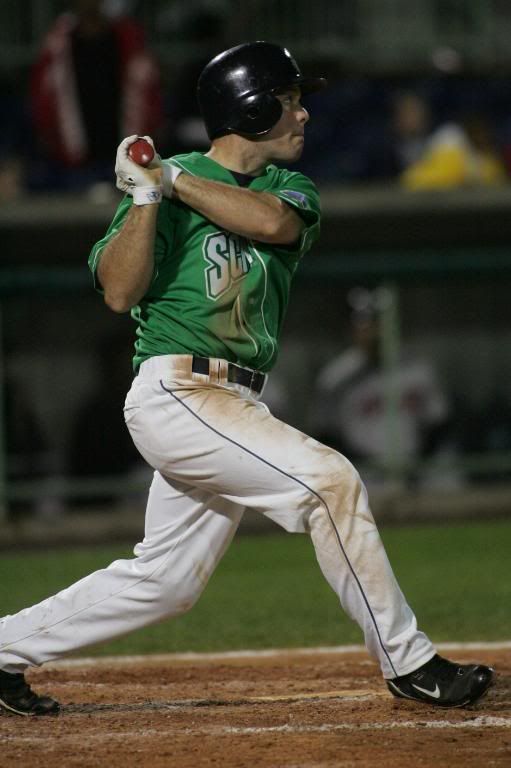 History: Fedroff was a 7th round pick in the 2008 Draft out of the University of North Carolina. He is another draft pick who came with a big pricetag and would have gone much higher in the draft if he had not scared teams away with his bonus demands. After selecting him, the Indians ponied up the money to sign him for $725,000 just before the August 15th signing deadline last year.
History: Fedroff was a 7th round pick in the 2008 Draft out of the University of North Carolina. He is another draft pick who came with a big pricetag and would have gone much higher in the draft if he had not scared teams away with his bonus demands. After selecting him, the Indians ponied up the money to sign him for $725,000 just before the August 15th signing deadline last year. Strengths & Opportunities: Fedroff a well-rounded player in that he has above average speed, has good range and an average arm in the outfield, makes good contact and has some pop in his bat to pound the ball gap-to-gap. He is a competitor who puts up some good at bats, puts the ball in play and gets his hits. At 5'11" 220-pounds there have already been some comparisons to the Giles brothers because of his short, compact build and the way he plays and performs with the pedal to the metal. He has a nice swing, and generates a lot of strength from his very strong forearms and wrists. He also displayed good plate discipline in his two-year playing career at North Carolina with a 54-54 strikeout to walk ratio in 130 college games (494 at bats).
At North Carolina he always played right field, but in his first few seasons in the organization he is expected to primarily play center field. He covers a lot of ground out in the outfield, and with his bat the Indians feel they may have a good offensive center fielder in the making. That said, because of his average arm he likely will find himself in left field when he reaches the upper levels of the system and potentially the big leagues.
Fedroff's average to above average skills across the board are the result of his high school coach making him work extra hard in the areas he needed improvement. Even with his well-rounded game, Fedroff still has things to work on. While he likes hitting, he believes he will need to make some big strides to become a better defensive outfielder, especially at a new position in center field, so he will be focusing a lot with the transition to center field this coming season and making that adjustment. As a runner, Fedroff is still considered very raw and many baseball people feel that his raw above average speed will only improve once he learns more technique, how to read the pitchers in the stretch, and the way the ball comes off the bat to go first to third.
Outlook: Outside of maybe Lucas Montero, Fedroff has the best combination of power and speed in the Indians system. After a nice debut at short-season Single-A Mahoning Valley in 2008, Fedroff should make the next step up on the minor league ladder and open with full-season advanced Single-A Kinston in 2009.
29. Matt McBride - Catcher
Born: 05/23/1985 - Height: 6'2" - Weight: 215 - Bats: Right - Throws: Right
| Year | Age | Team | Lvl | G | AB | R | H | 2B | 3B | HR | RBI | BB | SO | SB | BA | OBP | SLG | OPS |
| 2006 | 21 | Mahoning Vy | A- | 52 | 184 | 24 | 50 | 12 | 0 | 4 | 31 | 16 | 22 | 5 | .272 | .355 | .402 | .757 |
| 2007 | 22 | Lake County | A | 105 | 421 | 66 | 119 | 35 | 2 | 8 | 66 | 38 | 54 | 1 | .283 | .348 | .432 | .780 |
| 22 | Akron | AA | 2 | 7 | 2 | 4 | 2 | 0 | 0 | 0 | 0 | 0 | 0 | .571 | .625 | .857 | 1.482 | |
| 2008 | 23 | GCL Indians | R | 17 | 50 | 13 | 19 | 7 | 1 | 2 | 9 | 6 | 5 | 3 | .380 | .483 | .680 | 1.163 |
| 23 | Lake County | A | 11 | 39 | 6 | 12 | 4 | 0 | 1 | 7 | 5 | 5 | 0 | .308 | .386 | .487 | .873 | |
| 23 | Kinston | A+ | 17 | 67 | 9 | 12 | 2 | 0 | 0 | 6 | 7 | 9 | 0 | .179 | .263 | .209 | .472 | |
| Career | 204 | 768 | 120 | 216 | 62 | 3 | 15 | 119 | 72 | 95 | 9 | .281 | .356 | .428 | .784 |
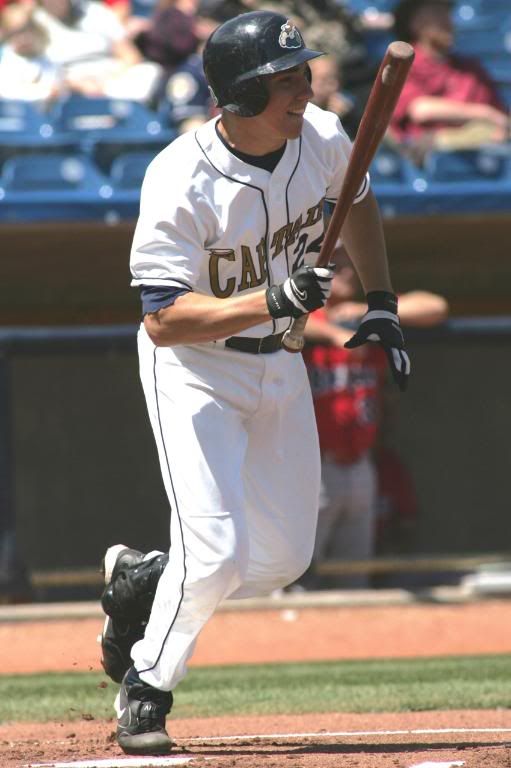 History: McBride was a 2nd round pick in the 2006 Draft out of Lehigh University. Prior to the 2008 season he was recognized by Baseball America as the fifth best catching prospect in the minors.
History: McBride was a 2nd round pick in the 2006 Draft out of Lehigh University. Prior to the 2008 season he was recognized by Baseball America as the fifth best catching prospect in the minors. Strengths & Opportunities: McBride provides a rare combination of defense and offense at the catching position. His strengths as a catcher are his catch-and-throw skills, especially his plus arm. His throws to second base consistently time at 1.85 which is considered above average. He also has a very cerebral approach behind the plate, and has shown good leadership qualities. While he is a big and strong catcher, he is also athletic and runs very well. He is a gamer who has excellent work ethic, and is sort of a throwback that hustles on every play and does not showboat.
McBride has good power potential, and has a very good eye and bat-to-ball ability. He has added a lot of strength and improved his physical makeup over the last year. In 584 at bats the last two seasons he has piled up 50 doubles which shows that as he matures he could be in line for a surge in the home run department as some of those doubles start turning into home runs. Also, in his short career, he has demonstrated the ability to put the bat on the ball and spoil tough pitches (95 strikeouts in 768 at bats). While he has shown very good ability to make consistent contact, he needs to be a little more patient at the plate to draw more walks (72 BB in 768 career AB). He also needs to try and use the whole field more as he has a tendency to pull the ball and has trouble laying off inside pitches.
McBride has had issues in the past with controlling the running game, which has been a result of him not being fundamentally sound with his feet, slow with his release and standing straight on his throws. His real problem stemmed from a lingering shoulder injury since the Indians drafted him, one that forced him to start his Indians career at short-season Single-A Mahoning Valley in 2006 as a designated hitter because he was still struggling with the shoulder. The ailing shoulder still bothered him after the 2007 season, so he had surgery to repair his right labrum in November 2007 and the rehab and recovery time from the injury forced him to miss half the 2008 season. He came back mid-way through the season, but he ended up barely catching and just got in the lineup as the designated hitter because the Indians felt his arm was not 100% and that he still lacked enough strength in his throwing shoulder to be able to throw.
Farm Director Ross Atkins approached McBride this offseason just before Instructional League started back in September about a move to the outfield. He was very receptive to the move and split time in Instructional League in the outfield and at catcher, and then went out to play in the Hawaii Winter League and exclusively played in the outfield. The Indians have not given up on him as a catcher though, as the move to the outfield was more a way to help him in his rehab from labrum surgery and also to give him some more versatility to play elsewhere in the field. With catching prospects Carlos Santana, Wyatt Toregas, and Chris Gimenez above him in Double-A Akron and Triple-A Columbus, some experimentation in the outfield is necessary to see if he could play somewhere else in the field. He should catch in 2009, but could get some time in the outfield as well to continue his development, which to date the organization has been pleased with what they have seen out there.
Outlook: There is no doubt McBride can hit. The question now is if his shoulder issues are behind him and he can get back to catching where he is most valuable. He has a lot of potential as a hitter and being able to hit is what is ultimately going to punch his ticket to the major leagues. McBride should open the 2009 season as the starting catcher at advanced Single-A Kinston, although there is an outside chance he could open the season in the outfield at Double-A Akron if they push him to the next level and make a more permanent position change to the outfield. (Note, since this report was written it has been learned that McBride will actually be playing in the outfield pretty much full-time this season.)
28. Eric Berger - Left-handed Pitcher
Born: 04/22/1986 - Height: 6'2" - Weight: 205 - Bats: Left - Throws: Left
| Year | Age | Team | Lvl | W | L | ERA | G | GS | SV | IP | H | ER | HR | BB | K | BB/9 | K/9 | WHIP |
| 2008 | 22 | U of Arizona | C | 8 | 4 | 4.34 | 18 | 13 | 0 | 74.2 | 70 | 36 | 4 | 34 | 67 | 4.1 | 8.1 | 1.39 |
| 2008 | 22 | Mahoning Vy | A- | 2 | 0 | 2.12 | 8 | 8 | 0 | 34.0 | 26 | 8 | 2 | 9 | 41 | 2.4 | 10.9 | 1.03 |
| 2008 | 22 | Lake County | A | 0 | 0 | 2.08 | 2 | 1 | 0 | 4.1 | 3 | 1 | 0 | 2 | 4 | 4.2 | 8.3 | 1.15 |
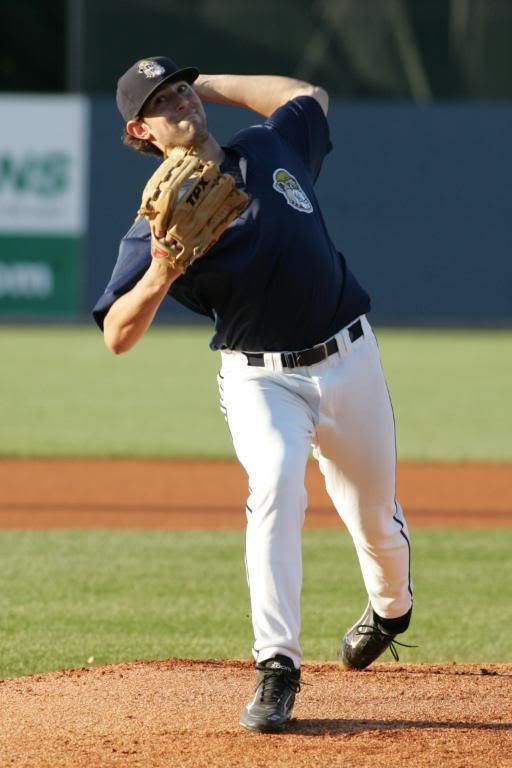 History: Berger was an 8th round pick in the 2008 Draft out of the University of Arizona. He started his 2008 season in the Arizona bullpen to build up arm strength since he was coming off Tommy John surgery in July 2006, and by the end of their season he was back in the starting rotation. He signed with the Indians quickly and was sensational in his professional debut at short-season Single-A Mahoning Valley. He got a late season call-up to Single-A Lake County, but in his first appearance strained an oblique in the third inning while trying to field a bunt. As a result he was shut down until the final week of the season and only made two appearances with Lake County.
History: Berger was an 8th round pick in the 2008 Draft out of the University of Arizona. He started his 2008 season in the Arizona bullpen to build up arm strength since he was coming off Tommy John surgery in July 2006, and by the end of their season he was back in the starting rotation. He signed with the Indians quickly and was sensational in his professional debut at short-season Single-A Mahoning Valley. He got a late season call-up to Single-A Lake County, but in his first appearance strained an oblique in the third inning while trying to field a bunt. As a result he was shut down until the final week of the season and only made two appearances with Lake County. Strengths & Opportunities: Berger has a standard three-pitch mix of a fastball, 12-6 curveball, and changeup. Before undergoing Tommy John surgery, Berger touched 96 MPH with his fastball but currently sits between 90-93 MPH now. When the 2009 season beings, Berger is expected to finally be 100% recovered from the surgery so there is a good chance that his velocity will kick up another MPH or two. The curveball and changeup grade out as average pitches, but while Berger shows more confidence in the changeup, his curveball has more depth to it and has the potential to be an above average offering and swing-and-miss pitch at the next level.
In his initial exposure to professional baseball, Berger established the ball down in the zone very well. Going forward, most of the focus will be in establishing a good second and third pitch to complement his plus fastball. Whether that means he keeps the changeup-curveball or the Indians scrap one of both of them for something else remains to be seen. In addition to developing his secondary pitches, the focus will be on getting him to continue working down in the zone and refining his command. He has been a little inconsistent with his command, but is to be expected coming back from such a surgery.
Outlook: Berger really threw the ball well last year in his professional debut, and is sort of carrying a chip on his shoulder because of all the teams that passed on him in the draft because of the injury. He is an advanced college pitcher, and a guy who should move quickly through the lower levels of the system. He should open the 2009 season in the starting rotation at advanced Single-A Kinston, and could possibly see time in Double-A Akron by the end of the season.
27. Alexander Perez - Right-handed Pitcher
Born: 07/24/1989 - Height: 6'2" - Weight: 156 - Bats: Right - Throws: Right
| Year | Age | Team | Lvl | W | L | ERA | G | GS | SV | IP | H | ER | HR | BB | K | BB/9 | K/9 | WHIP |
| 2007 | 18 | DSL Indians | R | 1 | 2 | 2.90 | 13 | 10 | 0 | 49.2 | 41 | 16 | 3 | 13 | 64 | 2.4 | 11.6 | 1.09 |
| 2008 | 19 | GCL Indians | R | 2 | 4 | 4.26 | 10 | 9 | 0 | 50.2 | 37 | 24 | 5 | 16 | 49 | 2.8 | 8.7 | 1.05 |
| Career | 3 | 6 | 3.59 | 23 | 19 | 0 | 100.1 | 78 | 40 | 8 | 29 | 113 | 2.6 | 10.1 | 1.07 |
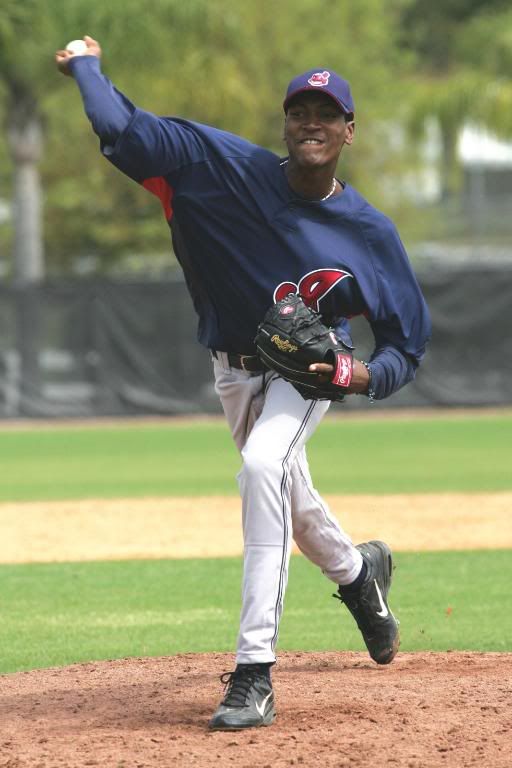 History: Perez was signed as an undrafted free agent in May 2007 out of the Dominican Republic. Last year, he finished 2nd in the Gulf Coast League with a .204 batting average against.
History: Perez was signed as an undrafted free agent in May 2007 out of the Dominican Republic. Last year, he finished 2nd in the Gulf Coast League with a .204 batting average against. Strengths & Opportunities: Perez throws a standard three pitch mix of a fastball, curveball and changeup. His fastball sits in the low 90s, and his arm works so easy that with maturity the Indians expect he is going to add more velocity. What makes him so special though is not only is he left-handed, but his two secondary pitches the curveball and changeup are much more advanced than most players his age and both have the potential to be plus pitches. His ability to throw both the curveball and changeup for strikes and command them well in the zone is something you don't see from a pitcher who turned 19-years old halfway through the Gulf Coast league season last year. The curveball is the slightly better of the two pitches, but both the changeup and curveball have the potential to be an out pitch at the major league level. They are weapons in the making.
Perez is a very loose bodied kid, and has a good frame that should fill out. At 6'2" and 156 pounds he will need to add more strength and bulk, which should happen over the course of the next few seasons, possibly even when he comes to camp this spring. He has been tough on hitters his first two seasons, holding them to a .218 batting average in 2007 and a .204 batting average in 2008. He has a career 4:1 strikeout to walk rate, and his career 10.2 K/9 to go along with his 2.6 BB/9 show his advanced command and ability to punch batters out and go right after them. If he begins to show more fastball velocity and command to go along with the secondary pitches he has, the Indians will have the makings of a big time starting pitching prospect.
Outlook: Perez will open the 2009 season at 19-years of age, which would be his freshman year if he were in college. He went on to have a very good inaugural campaign with the 2007 Dominican Summer League team, and last year on the Gulf Coast League team was the best pitcher on the staff and has the highest upside as a potential major league pitcher. He is the next big pitching prospect coming up from the lower levels of the Indians system who should become much more of a household name over the course of the 2009 season. Like previous Latin 19-year old predecessors Jeanmar Gomez, Hector Rondon, and Kelvin De La Cruz, he is expected to open the season in the Single-A Lake County starting rotation.
26. Cord Phelps - Second Baseman
Born: 01/23/1987 - Height: 6'2" - Weight: 200 - Bats: Switch - Throws: Right
| Year | Age | Team | Lvl | G | AB | R | H | 2B | 3B | HR | RBI | BB | SO | SB | BA | OBP | SLG | OPS |
| 2008 | 21 | Stanford U | C | 63 | 259 | 76 | 91 | 16 | 3 | 13 | 58 | 41 | 38 | 6 | .351 | .445 | .587 | 1.032 |
| 2008 | 21 | GCL Indians | R | 1 | 3 | 0 | 0 | 0 | 0 | 0 | 1 | 0 | 2 | 0 | .000 | .000 | .000 | .000 |
| 2008 | 21 | Mahoning Vy | A- | 35 | 141 | 24 | 44 | 10 | 2 | 2 | 21 | 15 | 22 | 4 | .312 | .376 | .454 | .830 |
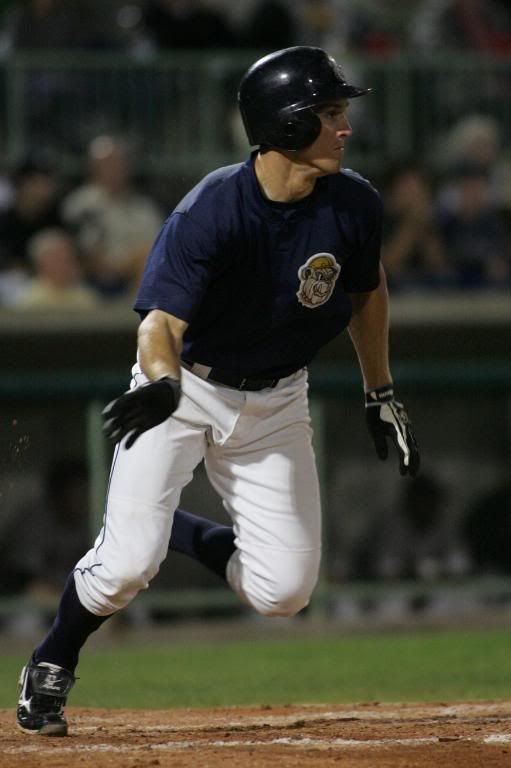 History: Phelps was a 3rd round pick in the 2008 Draft out of Stanford University. His professional debut was slowed by a sprained ankle he suffered prior to the College World Series, so he spent a few weeks in Winter Haven rehabbing the injury before moving on to short-season Single-A Mahoning Valley where he excelled.
History: Phelps was a 3rd round pick in the 2008 Draft out of Stanford University. His professional debut was slowed by a sprained ankle he suffered prior to the College World Series, so he spent a few weeks in Winter Haven rehabbing the injury before moving on to short-season Single-A Mahoning Valley where he excelled. Strengths & Opportunities: Phelps is the most complete player the Indians obtained in the 2008 Draft, and has an ability to impact the game in several different areas. He is a good base-runner, a great defender, and has a very polished approach at the plate. He handles himself really well at the plate and has a good gameplan, which was showcased by his 41-38 strikeout to walk ratio last year in college. He puts the ball in play and pounds the gaps, and has the potential to drive the ball more as he is still adding power. Prior to his junior season at Stanford, Phelps did not hit a home run in 278 at bats, but last year he ended up with 13 home runs in 259 at bats due to a spike in his strength and physical growth. Because he is a switch-hitter and has shown a good, patient approach at the plate he profiles as a #2 hitter and potentially could be a leadoff hitter. He is an above average runner.
While Phelps is firmly planted at second base, he does have experience at other infield positions which can create some versatility for him down the road to help him break into the big leagues. In addition to second base, Phelps also played third base and shortstop in college. Some scouts feel that he will eventually move to third base at some point, but given the lack of second baseman in the system the Indians will give him every opportunity to stay at second. He does a pretty good job at second base, moves around well, gets good reads on the ball and turns a good double play. He is just a very sound defender.
Coming out of an incredible program in Stanford he is a very mature, hardnosed professional baseball player. He also has excellent instincts as a baseball player on the field and on the bases. Phelps is still in the process of developing a routine and refining his approach at the plate. Also, while he is a patient hitter who often looks for a good pitch to hit, he is working on being a little more aggressive with his approach at the plate and to know what to expect in certain situations.
Outlook: This was an excellent pick by the Indians to fill an organizational weakness, and they may have finally found a solution at second base in the system. For years now second base has largely been the weakest position in their farm system, but that appears to be changing with the addition of Phelps to the mix. He has a pretty clear path to the big leagues, and because of his advanced bat and abilities, barring injury he will likely move fast through the system and has the potential to be an above average major league second baseman. He could be the first position player from the 2008 Draft to make it to the majors. Phelps likely will skip Single-A Lake County and open the 2009 season as the starting second baseman at advanced Single-A Kinston.
Photo courtesy of Ken Carr
Up Next: #25-21
- NBA Announces 2013-2014 Schedule
- Browns Ink Sharknado
- Sharknado A No-Show For Rookie Camp
- Trent Richardson Out Until Training Camp
- Browns Sign Brandon Jackson
- Carrasco Suspended Eight Games
- Browns Add to Wide Receiver Depth with David Nelson
- Browns Need to Learn from Past Draft Mistakes
- Browns Release Chris Gocong and Usama Young
- Browns Missing on Grimes Disappointing, But Not The End
The TCF Forums
- Official- Browns Coach Search/Rumors
Nicastro13 (Tuesday, January 21 2014 11:45 AM) - Chris Grant's first 3 drafts
Kingpin74 (Tuesday, January 21 2014 10:13 AM) - The 2014 Offseason Thread
googleeph2 (Tuesday, January 21 2014 9:36 AM) - 2015 Recruiting
furls (Tuesday, January 21 2014 6:57 AM) - Mike Brown
YahooFanChicago (Monday, January 20 2014 11:15 PM) - Movies coming out
HoodooMan (Monday, January 20 2014 9:34 PM) - 2014 Hoops Hockey Hijinx
jpd1224 (Monday, January 20 2014 4:44 PM) - 2014 Recruiting
jclvd_23 (Monday, January 20 2014 2:26 PM) - Wish List - #4 Pick
Hikohadon (Monday, January 20 2014 1:26 PM) - #1 overall pick Anthony Bennett
TouchEmAllTime (Sunday, January 19 2014 1:28 PM)



